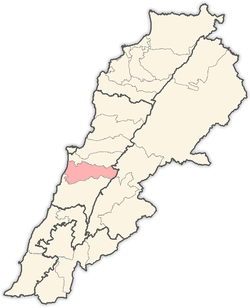Aley
| Aley عاليه | |
|---|---|
| City | |
 Aley Location in Lebanon | |
| Coordinates: 33°48′29″N 35°36′45″E / 33.80806°N 35.61250°E | |
| Country |
|
| Governorate | Mount Lebanon Governorate |
| District | Aley District |
| Government | |
| • Mayor | Wajdi Mrad |
| Area | |
| • Total | 3.30 sq mi (8.54 km2) |
| Elevation | 1,968-3,117 ft (600-950 m) |
| Population | |
| • Total | 100,000 |
| • Density | 30,000/sq mi (12,000/km2) |
| Almost doubles During the summer | |
| Time zone | EET (UTC+2) |
| • Summer (DST) | +3 (UTC) |


Aley (Arabic: عاليه) is a city in Lebanon. It is located 15 km uphill from Beirut on the Freeway that leads to Damascus. It is also the capital of the Aley District and fourth largest city in Lebanon and one of the most important cities in Lebanon. Aley earns the nickname 'Bride of the Summer' (عروس المصايف) due to its importance in Tourism. It earns also many other nicknames like 'The capital of the Mountains' (عاصمة الجبل) and the Lebanese 'City of Fog' (مدينة الضباب) due to its foggy weather even in the summer.
Demographics
Aley can be claimed to be the city with the biggest Druze population in the world. The natives are predominantly Druze; however, there are Christian Melkite, Orthodox, and Maronite minorities. Many outsiders, especially from Arab countries of the Persian Gulf, own homes in Aley where they spend their summers, escaping the heat and humidity in their own countries.
Etymology
The word "Aley" derivatives from Aramaic, and means "high place," referring to the town's high altitude above sea level. (up to 950m)
History
Aley gained prominence upon the completion of the Beirut–Damascus Railway in the mid-1890s. The railroad provided the residents of Beyrouth easy means of transportation to the mountains, and this made Aley a popular destination to spend the summer months and enjoy its pleasant climate.[1][2] It was the site of a serious accident on 12 April 1904, when part of the locomotive exploded and the train fell backwards down the 7% grade, killing 8 and seriously injuring another 21.[3]
The city was for a while the summer capital of the Ottoman governors of Mount Lebanon. Jamal Pasha made Aley his capital and organised a Diwan, where he executed a large number of Lebanese and Arab martyrs who sought independence from the Ottomans. Also, a Jewish community once frequented this multi-cultural city, and they maintained a synagogue in Souk Aley,[4] but it has since been abandoned. In 2001, the municipality of Aley began renovating the downtown area, especially its historic souk, and the city quickly revived its role in Lebanon's tourism.[5]
Tourism
Aley is a major tourist destination in Lebanon and the Middle East. Its location and climate made it a favorable venue for shopping and dining, especially for wealthy Arabs from Persian Gulf states. This resort city with its increasing number of tourists and visitors has become the most flourishing resort in Mount Lebanon, and thus has garnered its historical name as "The Bride of Summers". The "Souk Aley" is a relatively long historical boulevard lined with palm trees; there are numerous redroofed stone houses erected on the east side of the street while several street cafes, outdoor restaurants, and nightlife pubs occupy its western side. In addition to these, there are tens of antique shops and retail boutiques along the street, which forms the heart of Aley. Aley also hosts a well-known casino and many public swimming pools like the Piscine Aley, Country Club and Heritage. There's also many hotels like the Highland and the Golden Tulip that has a bowling arena and a public swimming pool and spa. There's also malls in Aley like the Aley Center, and many Lebanese and international restaurants. In 1910 Aley received the founders of the American University of Beirut (AUB), they built castles and lived there for several years.[6] During the 1960s several artists performed in the hotels and the casinos of Aley such as Umm Kulthum, Mohammed Abdel Wahab and Farid Al Atrash.[7] Aley is the capital of the Aley District and it has 18 municipality members.[8] In 2009 the municipality joined the Yasa in a safety program to reduce the rate of accidents.[9]
Educational and Health Institutions
The municipality contains 14 schools, 4 public and 10 private. The largest, oldest, and most important of these schools is the Universal College of Aley (UCA) which is considered one of the best schools in the country. It was built in 1907 by Mr. Shebl Khoury. There are also 2 universities in the city: the Lebanese University-Faculty of Economic Science and Business Administrations, and the Modern University of Business and Science (MUBS). There's also the Balamand University located in Souk Al Gharb, a village close to Aley. Aley has 3 hospitals: The National Hospital of Aley (30 beds), Al Iman Hospital (52 beds), and Al Ouyoun Hospital, which specializes in ophthalmology.
References
- ↑ Aley.
- ↑ Facebook.
- ↑ "Unfall auf der Hauranbahn [Accident on the Hauran Road]", Die Lokomotive: Illustrierte Fachzeitung, Vienna: Kaiserlich-Königliche Hofbibliothek, May 1904, p. 49. (German)
- ↑ Flickr.
- ↑ ESCWA.
- ↑ "American University of Beirut - Natural History Museum - AbbyBliss". Aub.edu.lb. 1999-05-07. Retrieved 2013-01-31.
- ↑ William MATAR (2006-01-01). "City of Aley, sculptures symposiums, paintings, glamour, Abdul Wahhab, traders buyers, festivals crowd". Discoverlebanon.com. Retrieved 2013-01-31.
- ↑ "Municipality Members and Mukhtars for Aley Villages". Aley-Ads.com. Retrieved 2013-01-31.
- ↑ "YASA". YASA. 2009-12-09. Retrieved 2013-01-31.
Coordinates: 33°48′N 35°36′E / 33.800°N 35.600°E
